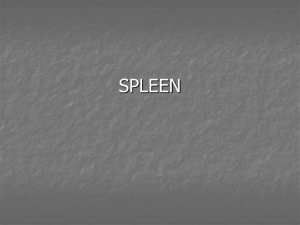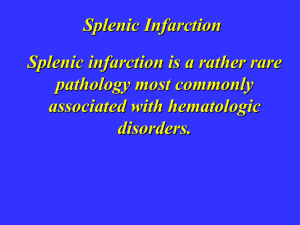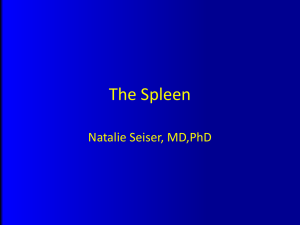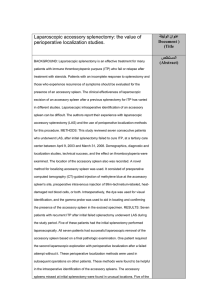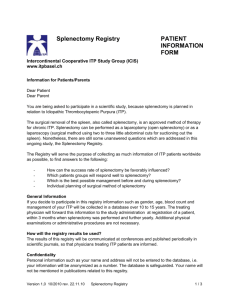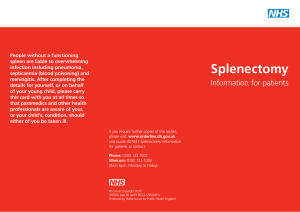SPLENECTOMY FOR DISEASE AND MANAGEMENT OF CONDITIONS OTHER THAN TRAUMA
advertisement
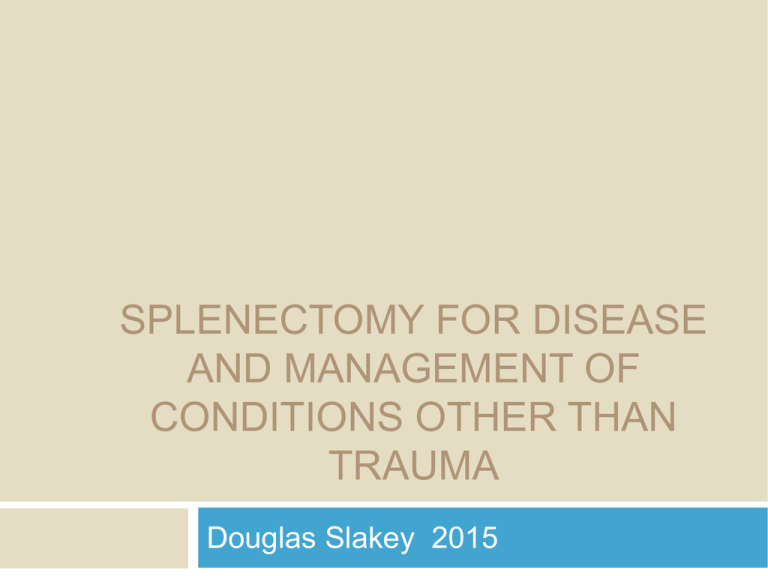
SPLENECTOMY FOR DISEASE AND MANAGEMENT OF CONDITIONS OTHER THAN TRAUMA Douglas Slakey 2015 Outline This lecture will focus on the management of diseases that may require surgical treatment, including splenectomy. 1. Cysts and Tumors of the Spleen 2. Splenic Abscess 3. Indications for Splenectomy (other than trauma) Cysts and Tumors of the Spleen Splenic masses are rare compared to other abdominal organs History and Physical Patients are often asymtpomatic (30-45%)– masses discovered incidentally May have RUQ pain Most common 10-30 years of age, but can occur at any age. Imaging Ultrasound – differentiate cystic from solid CT or MRI Cysts and Tumors of the Spleen Solid Masses Lymphoid Hodgkin Non-Hodgkin Nonlymphoid Benign Malignant Cysts and Tumors of the Spleen Cystic Masses Primary (True) Parasitic (Echinococcus granulosus most common) Congenital (10% of all cysts) Neoplastic Include endodermoid, dermoid, epidermoid Pseudocysts (75% of all cysts) Post-traumatic – patients often cannot recall specific traumatic even May be related to silent splenic infarct Other Cysts of the Spleen Risk of Cyst rupture is 25% if >5cm CA 19-9 and CEA may be elevated Treatment Aspiration may be considered, but risk of bleeding and recurrance – spread of malignant cells if present Partial splenectomy or fenestration if certain pseudocyst Precautions as for liver cysts if parasitic Total most common treatment Prior to any splenic Surgery Immunization Streptococcus pneumoniae Neisseria meningitidis Meningococcus Post splenectomy sepsis Incidence is 0.2% to 4.3% Lifetime risk 5% Solid Tumors of Spleen Uncommon Tumors may be diffuse or localized within spleen Lymphoid tumors first arise in white pulp Splenectomy indicated for staging protocols (not common today) Hypersplenism, pain Solid Tumors of Spleen Primary Hemangiomas Most common benign tumor Usually asymptomatic May cause unexplained consumptive coagulopathy Lymphangiomas, hemangioendotheliomas May cause symptoms from mass effect Rare tumors: hamartomas, lipomas, fibrosacroma, and others Solid Tumors of Spleen Metastatic, secondary Uncommon Primary may be: melanoma, breast, lung Primary hemangiosarcoma Rare, but most common primary splenic malignancy Grow rapidly and metasize early May rupture spontaneously Management of Splenic Abscess Symptoms highly variable, may be asymptomatic May be associated with left pleural thickening, pneumonia Ultrasound 75-90% sensitive Irregular thickened wall, look for internal septations, debris Can be found in immunosuppressed patients Management of Splenic Abscess Many potential organisms, aerobic and anaerobic Polymicrobial in up to 36% Fungal in 25% Most common candida Mycobacterium in 4 – 7% Management of Splenic Abscess If untreated, uniformly fatal Medical treatment alone – 80% mortality First-line treatment percutaneous drainage Lowest initial mortality, but 30% recurrence rate Allows for culture Monitor with repeat US / CT Complications – bleeding, hemothorax, pneumothorax Management of Splenic Abscess Laparoscopic drainage If percutaneous not feasible Antibiotic therapy 10-14 days with drainage If recurrence, or persistent abscess then total splenectomy Splenectomy for other Conditions Typically for cytopenia and/or splenomegaly Failure of medical treatment if applicable Weigh risk vs. benefit Indivdualize treatment Risk of splenectomy is low for experienced surgeons Normal spleen weight: 90-150g. Splenomegaly defined as weight more than 175 g. Splenectomy for other Conditions Thromocytopenia Platelet count < 150,000 / microL Idiopathic Thrombocytopenic Purpura (ITP) Most common indication Splenic macrophages clear platelets coated with IgG autoantibodies Test for autoantibodies Sensitivity 49-66% Specificity 78-92% Splenectomy for other Conditions ITP Response to splenectomy 67% (range 37% - 100%) Younger age (<30) at time of splenectomy - better outcome Accessory splenic tissue in up to 30% Possible locations: splenic hilum, gastrocolic ligament, greater omentum, mesentary, pre-sacral space Splenectomy usually avoided during pregnancy If necessary, 2nd trimester preferred Splenectomy for other Conditions Thrombotic Thrombocytopenia Purpura (TTP) Can be lethal Pentad: thrombocytopenia, hemolytic anemia, fever, renal dysfunction, neurologic impairment Peripheral schistocytes (fragmented erythrocytes) Microvascular thrombosis Total plasma exchange is preferred treatment Splenectomy for relapse or refractory patients Significant surgical morbidity for these patients Splenectomy for other Conditions Systemic Lupus Erythematosus Antiplatelet antibodies in 78%, severe thrombocytopenia in 8-20% For refractory patients splenectomy has response rate similar for ITP HIV Subset of patients with thrombocytopenia refractory to medical treatment have favorable response (80+%) to splenectomy Splenectomy for other Conditions Wiskott-Aldrich Syndrome X-linked immunodeficiency disorder Thrombocytopenia most common manifestation Splenectomy indicated for patients who fail medical management, or who are ineligible for bone marrow transplant Disorders Causing Anemia Hereditary Anemia Hereditary spherocytosis For moderate to severe disease splenectomy is indicated. Typically between 6 yo – to puberty Other disorders where splenectomy indicated if medical manamgnet not effective: Glucose-6-phosphate dehydrogenase deficiency Sickle cell anemia Thalassemia major Acquired hemolytic anemia Splenectomy for other Conditions Splenic artery aneursym Third most common abdominal aneurysm After aortic and iliac Most common in multiparous women Mortality if rupture while pregnant – 70% for mother, nearly 100% for fetus Splenectomy may be necessary, but not always – depends upon anatomy All symptomatic aneursyms need surgery If > 2.5 cm Splenectomy for other Conditions Portal hypertension, splenic vein thrombosis If severe, symptomatic thrombocytopenia and no contraindications, may consider If bleeding from gastric varices (unusual indication) Wandering spleen When spleen is attached by long, loose vascular pedicle May cause torsion, abdominal pain. Children – splenopexy to diaphragm Adults - splenectomy The End

